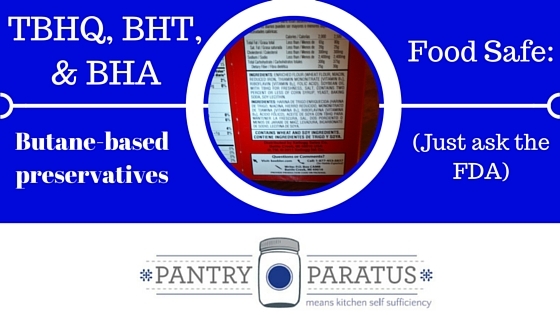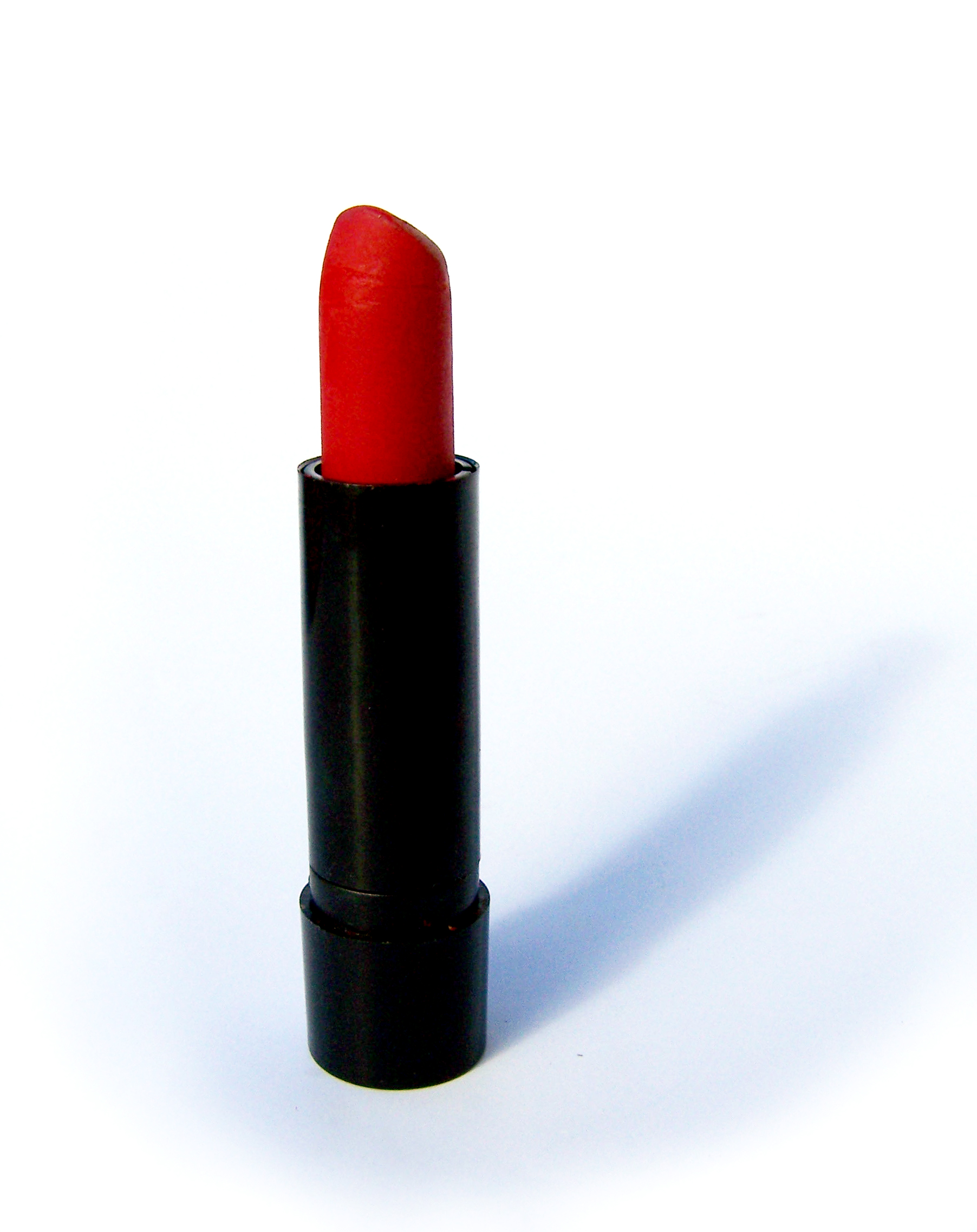
Everyone must make their own decisions about the allowable level of toxins permitted into their home and I am not one to preach. The Toxin Police coming into my home will see a scented candle, a small container of coffee, and even a bottle of carpet cleaner. The journey to a fully healthy and sustainable home is far from complete for me, as I am sure it is still a work in progress for most of my readers. So no judgments here.
I recently fell off the wagon and purchased a store-bought cracker that I grew up crushing into my chili. Aahh, comfort food. I no longer find comfort in it: It contains TBHQ.

TBHQ, BHT, BHA. They are variations of the same thing.
What is TBHQ? TERTIARY BUTYLHYDROQUINONE
TBHQ increases shelf life because it stabilizes fats, and has a stabilizing effect for explosives (as a side note). It is derived from petroleum and is related to Butane and not too distant from lighter fluid. Apparently, while most studies show that this can lead to cancer, there is even contradictory study that show it might be a cancer preventative (see source #1) since it is a “synthetic antioxidant”. Hmmm, makes you wonder who’s funding which study but that’s a blog for another day.
It isn’t just reserved as a synthetic preservative for your synthetic crackers. It’s sprayed on nuts, it’s blended into the seasoning mix of sausages and other meats. It’s sprayed in fast food cartons and appears in the oils of both fast food and packaged food alike. 
What is BHA? BUTYLATED HYDROXYANISOLE
BHA is found in:
- Cosmetics (especially lipsticks and eye shadows)
- Butter, meats, cereals, chewing gums, snack foods, commercially dehydrated foods, nuts, etc.
- Beverages
- Edible Fats and Oils (shortening, etc)
- Pharmaceuticals (over the counter and prescriptive)

What is BHT? BUTYLATED HYDROXY TOLUENE
According to the company who produces it, “The antioxidant activity of BHT (Food Grade) can be transferred to baked products if it is used as an antioxidant in the shortenings used in their manufacture” (see source #2). You body can metabolize it (#6) and its affects are due to exposure accumulation. It is more commonly found in meat, fish, and bone meals than its TBHQ and BHA relatives, although it is commonly used in conjunction with BHT. Check your vitamin and fish liver oils that you may have in your pantry for this combination. 
So what, why care? Isn’t this another case of how everything is going to kill us?
I will cite the FDA regulation here: “The total antioxidant content of a food containing the additive will not exceed 0.02 percent of the oil or fat content of the food, including the essential (volatile) oil content of the food.”
Why does the FDA, deeming the preservative safe, limit it to far less than 1% of the oil used? How much of the food item contains oil, and then .02% of that oil—aren’t we talking trace amounts? Yes. So the FDA says that on one hand TBHQ (and its’ relatives) is completely safe. On the other, they do not allow more than trace amounts in any one food item.
This is why the FDA limits it— 5 grams is death. 1 gram (up to 4 grams) produces the following side effects: nausea, vomiting, tinnitus (ringing in the ears), delirium and collapse. There is limited evidence of hyperactivity, restlessness, and ADHD-like symptoms in children.These side effects are considered rare because of the amount of food required (with the current FDA regulation of .02% of oil) to quantitatively measure these effects.
But does the average family only eat one item with this additive a day? A week? A month? How many servings is the average family eating—because after all you cannot stop after 1 potato chip? How much, especially in combination with all of the other toxins present in food, is the average 40-pound child consuming? Is there an accumulative effect? In a moment of honesty, I unearthed the notes of an FDA committee meeting in which it was stated that there is indeed an accumulative effect:
They tolerate a small amount, sometimes, for a while. But if they now think, I’m all cured, I can do this, and they begin eating at Taco Bell or something, which has BHT, TBHQ, and everything, and they think they’re okay, after they’ve done this for a few weeks, they’re not okay anymore. So there is some tolerance that’s built up. And these children, once they are off the diet — remember, you’re taking away thousands of additives when you put them on either the Feingold diet or an oligoantigenic diet, then you’re picking one thing and testing them. (see source #5)
Wherever I found a resource (such as a science blog) that allowed reader’s comments, I found a myriad of postings from average people who had simply internet-searched because “I ate McDonalds for the 1st time in years, and vomited for hours. I read the ingredients and this was the one thing I didn’t know about”…or “I never had a problem with this until pregnancy.” How many times do you read the above “anecdotal” problems of others before a warning bell goes off in your head? And remember, it’s only “anecdotal” until you’re the one hugging the toilet bowl.
As usual, I read a crazy number of sources for the blog, but either I did not find sufficient documentation or they simply repeated more reliable sources, so I do not list them below. I want you to research for yourself so I only list the sites I most highly recommend to you. I tend to go straight to the horse’s mouth, so you’ll find a site listed below that is the manufacturer’s attempt at making you think they’re doing you a favor. You’ll also see some FDA sites and science blogs, to include a dog food advisory site. As always, I want to encourage you to review these sources personally and find a few of your own.
(1) http://www.dogfoodadvisor.com/red-flag-ingredients/tbhq-dangeorus-dog-food-preservative/
(3) http://www.ehow.com/facts_5594973_tbhq-side-effects.html
(4) http://www.accessdata.fda.gov/scripts/cdrh/cfdocs/cfcfr/CFRSearch.cfm?fr=172.185
(6) http://www.ncbi.nlm.nih.gov/pubmed/12396675
If your family struggles with an unknown food sensitivity, I would like to suggest you check out: http://www.feingold.org/
Proviso:
Nothing in this blog constitutes medical or legal advice. You should consult your own physician before making any dietary changes. Statements in this blog may or may not be congruent with current USDA or FDA guidance.
Want to keep learning and growing in your ability to produce, prepare, & preserve your own fresh harvest? Sign up here for something (about bi-weekly):
Photo Credits:

Honestly, I don’t what to eat. Sometimes I feel awful – I can’t be sure which food product is healthy, and which is just pretending to be one….. This was really helpful post, thank you!
Keira, I know exactly what you mean. Sometimes I hesitate to research or write about this stuff because it can be discouraging to think of how much junk is out there. In the end, it’s better to be informed, so you CAN play with your diet and discover your healthiest self. I would like to recommend to you the Weston A. Price Foundation (WAPF) and their emphasis on traditional foods. The human body knows what to do with those. In the meantime, keep reading & shopping our site–we want to help you get to your best!
The fda is a major reason cancer is such a big problem, due to the fact they allow chemicals intended for industrial use to be used in the food supply calling it industry standard.
I completely agree. Cancer has always been around, since the beginning of time, but it wasn’t a household word. Nor does every country deal with our prevalence of it. No one could deny that the prevalence is purely related to “environmental factors” and I suppose people could argue all day long about what those are. For me? I’ll stick to natural foods as much as I can, thank you.